1842 Gold Discovery Site, Placerita Canyon, California
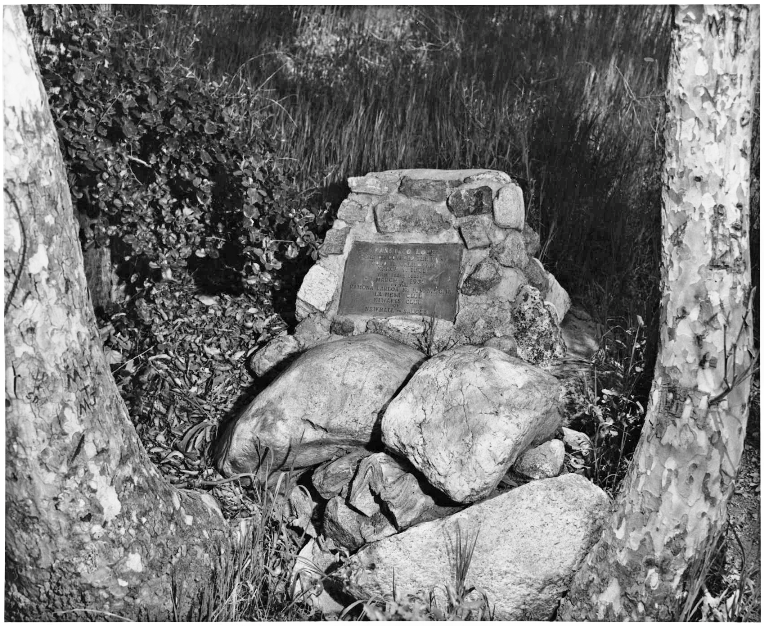
1959 photo from the University of Southern California Libraries, California Historical Society Collection.
The image above shows a stone marker and plaque commemorating Francisco Lopez's discovery of the first gold in California. The plaque says "Francisco Lopez here discovered the first gold in California March 9, 1842. This plate placed March 9, 1930 by the Ramona Parlor No.109 N.S.G.W., La Mesa Club, Kiwanis Club, Newhall -- Saugus". However, Lopez found the first documented gold, not the first gold. There were reports of gold long before 1842. In 1930, the plaque was just placed on stones, not cemented in like this 1959 photo shows. The cementing in place was not done until 1941. Today, there is no trace of that monument. What happened to it?
In 1843, one year after the discovery, Francisco Lopez organized a ceremony in Placerita Canyon at the gold discovery site to mark the one-year anniversary of the event. Scores of people were there for a religious mass and picnic. Catalina Lopez de Lopez, a niece of Francisco's, was there when she was 11 or 12 years old. The mass was held at the discovery site where a chapel made of brush was built. There was a barbecue served under the oak where Lopez had taken a siesta before he found gold. In 1914, 71 years later and when Catalina was about 83, a family reunion was held at the Placerita Canyon discovery site so that she could share the gold discovery story with the family before she died. Francisca Lopez de Belderrain, a great-grandniece of Francisco Lopez, was also there. (From Belderrain, "The true history of the first discovery of gold in California in 1842", 1930, published privately.) After the reunion, Francisca wrote of her ambition to see that her relative, Francisco Lopez, was properly honored as the state's first discoverer of gold.
She finally located the landowner of the site in Placerita Canyon - Frank Walker. Walker and his wife agreed to donate the land at the discovery site for a small park with a memorial to Lopez. With the help of local organizations (indicated on the above plaque), a ceremony was planned for the 88th anniversary of the gold discovery in 1930. Before the ceremony, Walker volunteered to clean up the area. While clearing out the brush, he found a stone monument that was then claimed to be the original gold discovery monument that had somehow managed to remain standing for 88 years of intensive placer mining in the canyon. Belderrain never explained anything about the monument or said that one was ever built. She only said that Walker found it.
On March 9, 1930, the ceremony took place to mark the site where gold was discovered by Francisco Lopez in 1842. During the ceremony, a temporary plaque was placed on the pile of boulders found by Walker at the discovery site. A plaque was also affixed to a nearby oak tree, which was given the name of The Oak of the Golden Dreams. Added to the gold discovery story was that while Lopez was resting, he had fallen asleep and dreamed that he would discover gold. After awaking, he dug up onions from the ground nearby and discovered gold in the roots. However, before 1930 no one, including Lopez himself, had ever claimed that Lopez had fallen asleep under the oak and dreamed of finding gold.
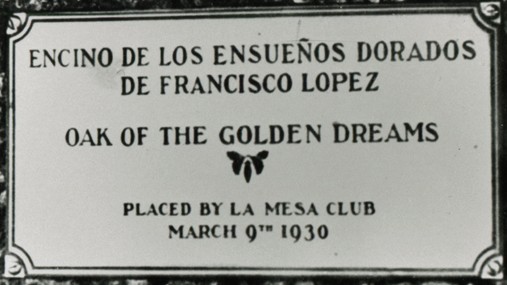
The Santa Cruz Sentinel of August 27, 1885, reports on a discovery account by Abel Sterns actually from Lopez. Sterns was the man who, on November 22, 1842, sent the Philadelphia mint about 20 ounces of gold from the newly discovered placer deposit. The ensuing paperwork made this the first documented gold in California history. In a letter to the Society of Pioneers in 1867, Sterns wrote that the gold came from placer mines "discovered by Francisco Lopez, a native of California, in the month of March, 1842, at a place called San Francisquito, about thirty-five miles north-west of this city [Los Angeles]. The circumstances of the discovery by Lopez, as related by him [to Sterns], are as follows: Lopez with a companion, was out in search of some stray horses, and about midday they stopped under some trees and tied their horses out to feed, they resting under the shade; when Lopez with his sheath knife dug up some wild onions, and in the dirt discovered a piece of gold, and searching further found some more. He brought these to town and showed them to his friends, who at once declared there must be a placer of gold." Other early accounts place the discovery in San Feliciana Canyon and then Placerita Canyon. No dream was ever mentioned.
After 1930, newspapers took liberties with the dream story. The Signal of 5/7/1936 said that "The sleep of the vaquero, his dream and the gold he found...", but it did not actually say that he dreamed of finding gold. The LA Times of 3/9/1942 reported that "The golden dreams of Francisco Lopez turned today from fancy to fact." and "...Placerita Canyon, where Francisco Lopez idled and dreamed". In the LA Times of 5/7/1956, "They paused [Lopez and his servant] for a siesta under a huge, gnarled oak and soon Lopez had a dream, a dream that he had found gold." In the Signal of 11/8/1971, "According to legend, Lopez dreamed of discovering gold." Now that it was a legend. In the Signal of 6/24/1984, Jerry Reynolds writes "Along about noon they paused to rest under a massive oak tree where, according to legend, Lopez fell asleep dreaming that he was floating on a pool of gold." In the Signal of 1/25/1998 (by Alecia Foster), "It is said that there, he dreamed of riches beyond belief."
See Alan Pollack's "Dissecting the Dream" story on the SCV History website. The SCV History website also has many other articles on the gold discovery and much more information about Placerita Canyon. I am only using de Belderrain's version here, there are others. Her version (and the others) is probably not totally accurate, but I am only concerned here about the fate of the gold discovery monument and plaque.
The Van Nuys News of 4/25/1930 said that there were "plans to erect a magnificent, permanent monument of granite in the near future." Santa Clarita Valley historian Arthur B. Perkins (who was at the 1930 ceremony and had a hand in the planning) wrote that the temporary plaque would "serve as a land marker until a more suitable monument could be built." In 1936, the temporary plaque was stolen for the second time and not found until 1938, when it was discovered on the Ridge Route (Signal 7/28/1938). It would not be replaced at the site until 1941. On July 13, 1941, the plaque was finally rededicated during another ceremony and "firmly fixed in a cairn of native boulders imbedded in concrete" (Signal 7/18/1941).
Russ Leadabrand (Pasadena Independent 1/12/1959) wrote "I returned to the Placerita Park area, looked up the tree the deputy had mentioned, scouted around and in a nearby thicket found the marker. But it's not easy. It's a real challenge." From Metal, Mining & Processing magazine (1965, Vol 2, Issue 1) - "Today, a plaque about 50 feet from the oak in a clump of sycamores commemorates the discovery."
As time went by, stories of the gold discovery moved the actual site to the Golden Oak or close to the oak. The discovery monument with plaque was not mentioned. From the Signal of April 22, 1970 - "The site of Don Francisco's original gold find is now a State Historical Monument, and bears the title 'The Oak of the Golden Dream,' paying tribute to the location, and to the giant oak tree which still grows in Placerita Canyon. The original strike area, where wild onions bearing gold nuggets clinging to the roots were found, was adjacent to the giant oak." In the Signal of March 20, 1981, Jerry Reynolds wrote that: "Our history books show that the first gold rush in California occurred, not on the American River at Sutter's Mill, but in Placerita Canyon on March 9, 1842. The Oak of the Golden Dream marks the spot." False. Later, in the "Tales of the Valley" story in the 2/23/1991 Signal, Reynolds displays an old photo of the discovery monument with the caption "In 1930, this plaque was erected at the Oak of the Golden Dream, which told of the discovery of gold. Today, that plaque no longer exists at the site for it has been stolen." Yes, the plaque no longer exists but the site was not at the Golden Oak.
The actual 1930 gold discovery site with the "cairn of native boulders" and the plaque "imbedded in concrete" was lost and forgotten.
My goal was to find the discovery site and see if the stone monument with plaque were still there. The site must have been reasonably close to the oak, but in what direction? What side of the road?
During the ceremony of 1930, a panoramic photo was taken which showed all the people there and the stone pile at the gold site location. The Oak of the Golden Dream was not in the photo. The following is that photo.

The stone pile with the plaque laying on top is at the far left. Could I find the mountains in the background that match the ones in this photo?
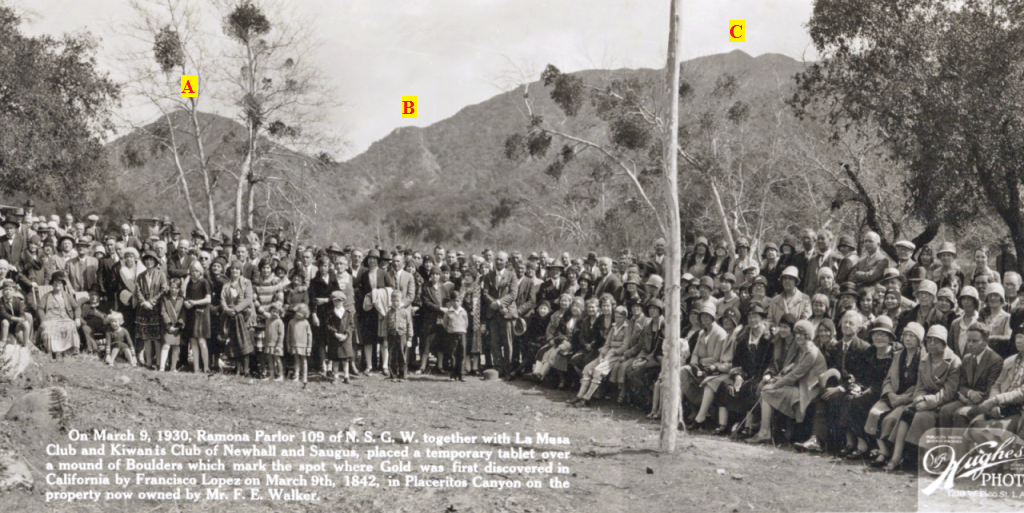
Here is the right middle of the panorama with a closer view of the mountains in the background.

That background can be seen here and points A, B, and C are obviously the same here and in the 1930 photo. I am standing on Placerita Canyon Road looking upstream towards the east. The entrance to the park is just past the 45 mph sign on the road. I am higher and closer to the mountains compared to where the 1930 photo was taken. This is about the only place that I can clearly see all the mountains in the background. The trees have grown too tall to take a photo at ground level. The road was completed in 1956, so the 1930 photo was done at creek level without today's road in the way. The stone pile monument was obviously either buried by the road or was on the other side of the road. I knew it couldn't have been buried by the road because there were photos of it after the road was built. (Photo taken on 2/8/2019)
Now that I knew that the stone monument on the Oak of the Golden Dream side of the road, I needed to focus on the oak. Was there a pre-road photo that would help my search? Yes. There is a photo taken in 1949 where it looks like there are some rocks in the background among the trees. Here it is:
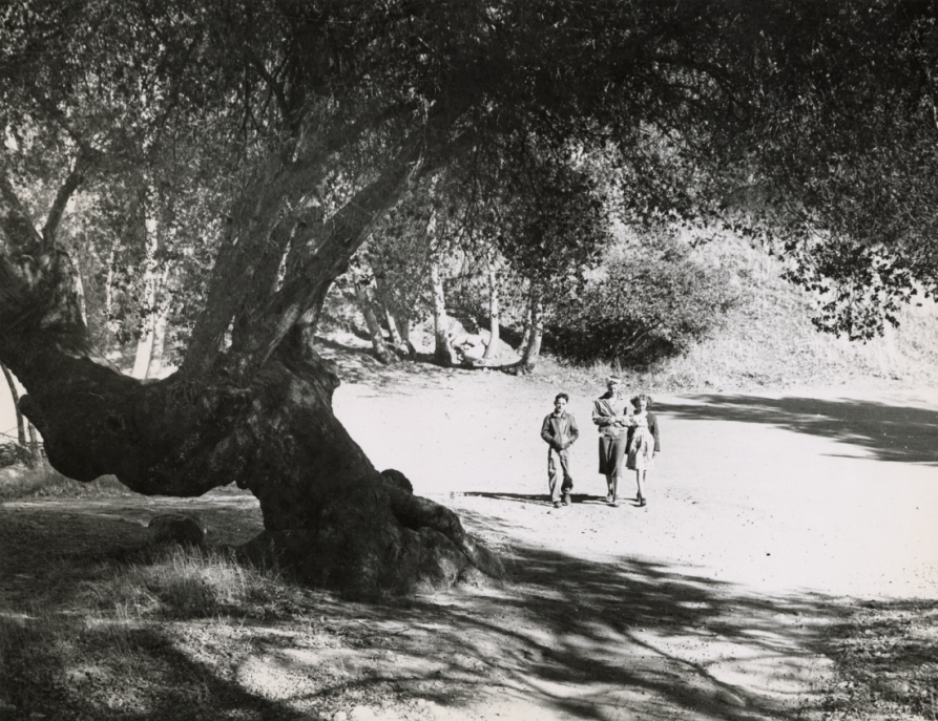
Title: David Fraser and Alice and Helen Flint by "Oak of Golden Dreams" in Placerita Canyon Park. Photo date March 4, 1949. From the Valley Times Collection, Los Angeles Public Library.
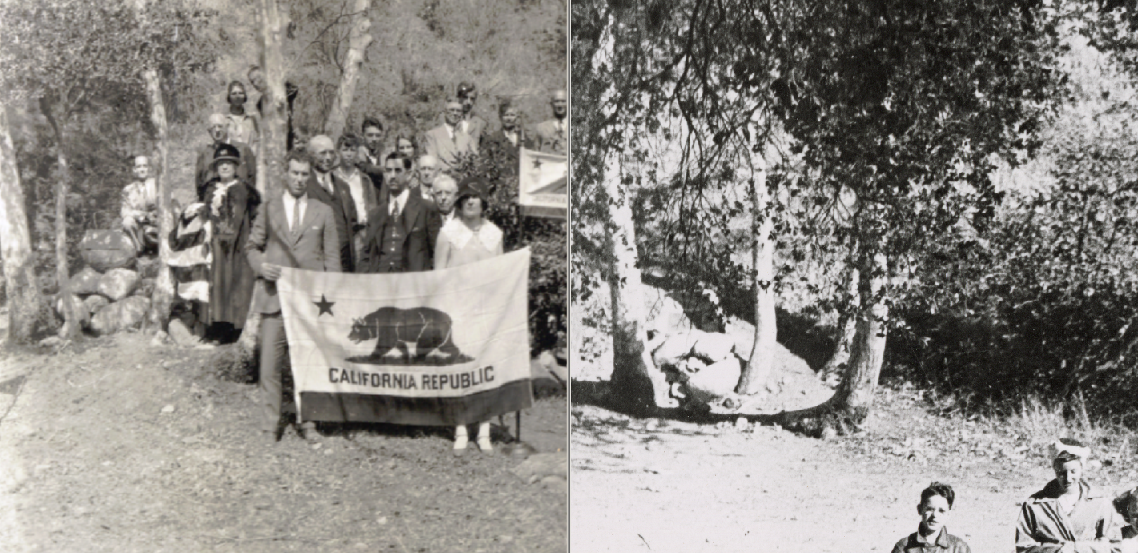
Comparing the 1930 photo with the 1949 photo shows how similar they are. The only difference is the large boulder with the plaque laying on it.
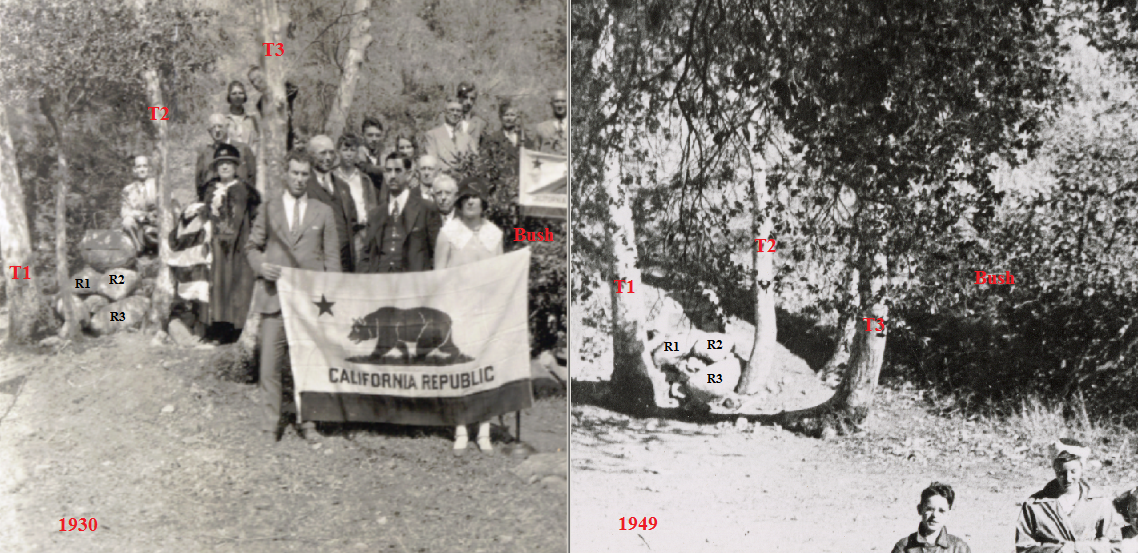
Labeling them shows they are the virtually the same - same tree positions and shapes (T1, T2, T3) and same shaped rocks (R1, R2, R3). There is also a bush on the right side. The only difference is the plaque rock in the 1930 photo. By 1949, the plaque was mounted on a cairn of rocks behind three numbered rocks and the big rock supporting the plaque was gone. The cairn with the plaque is not visible in the 1949 photo because either the photo is not clear enough or the cairn is not visible (it was not very tall). But there is no doubt that this is the gold discovery rock pile.
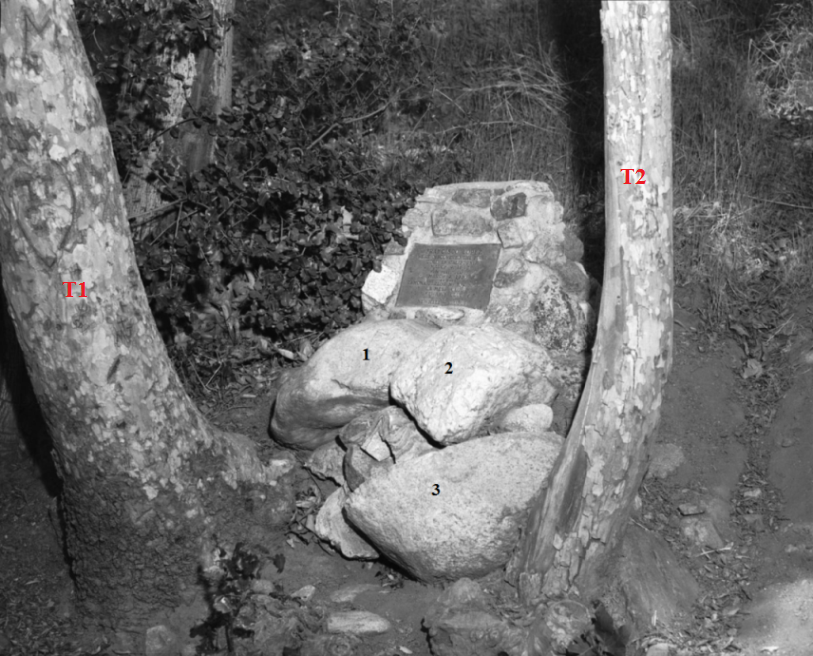
Closer view of the rocks with my numbers added and the cairn with the plaque in the back. Photo date 1959. From the University of Southern California Libraries, Automobile Club of Southern California Collection.

Other photos of the oak also show the stones in the background. Undated post card. Stones in red circle. There are people at the stones.
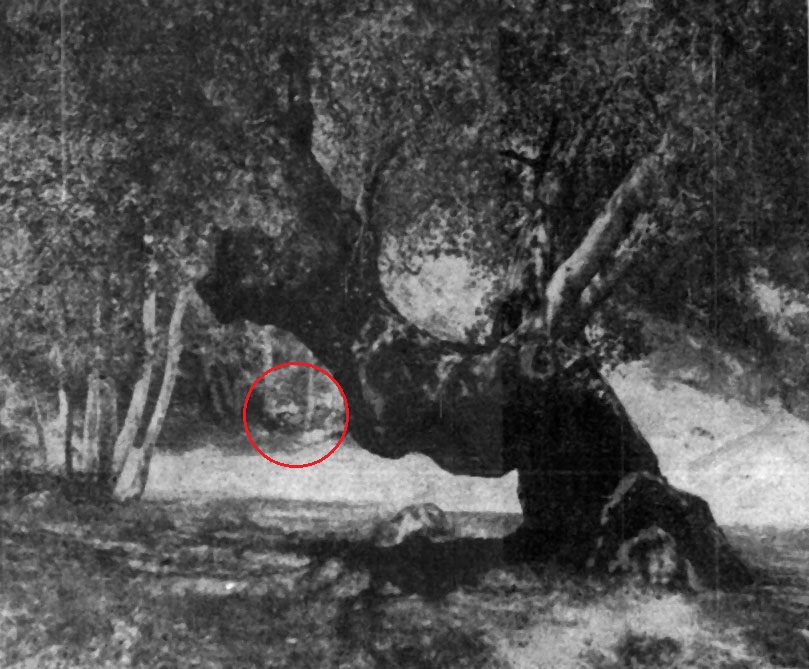
From the LA Times of May 28, 1950. Hard to see, but in the red circle.
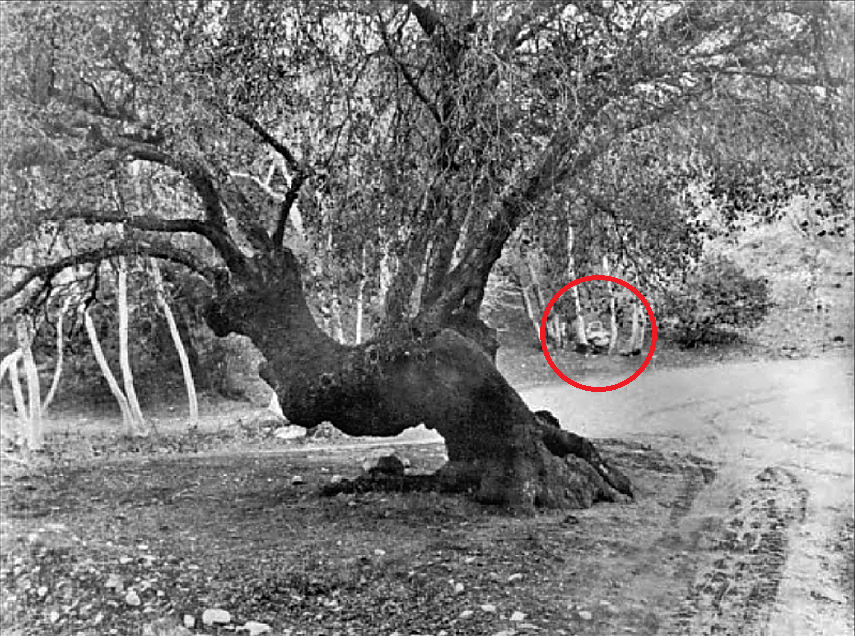
This undated photo clearly shows the rocks and plaque. From the book "Newhall" by Maggie Perkins (granddaughter of Arthur B. Perkins), Arcadia Publishing, 2010.
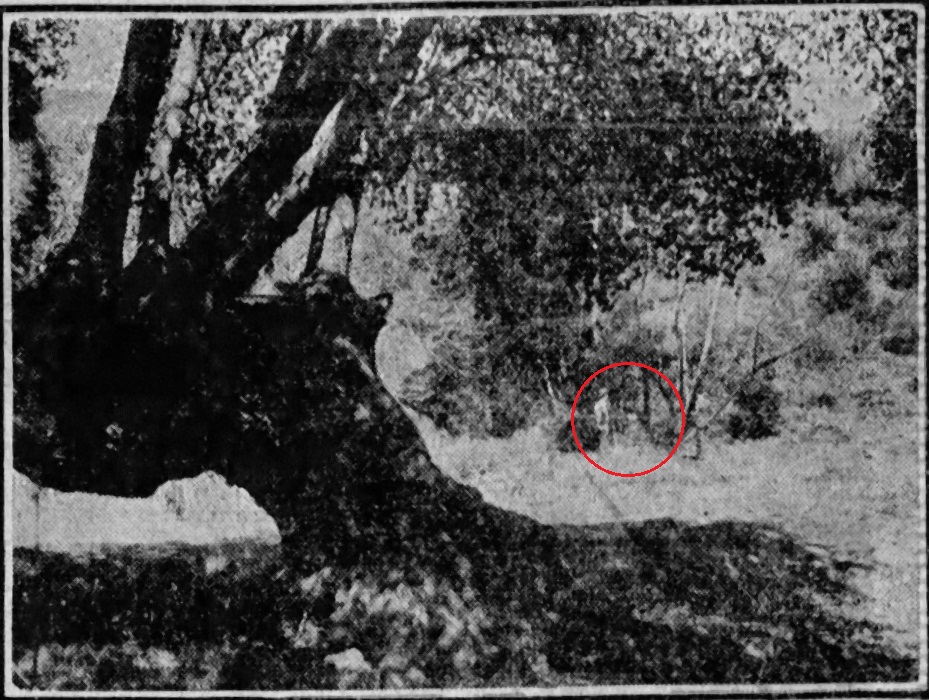
This photo is from the Los Angeles Evening Express of March 12, 1930. The man standing in the background is looking at the gold discovery rocks.
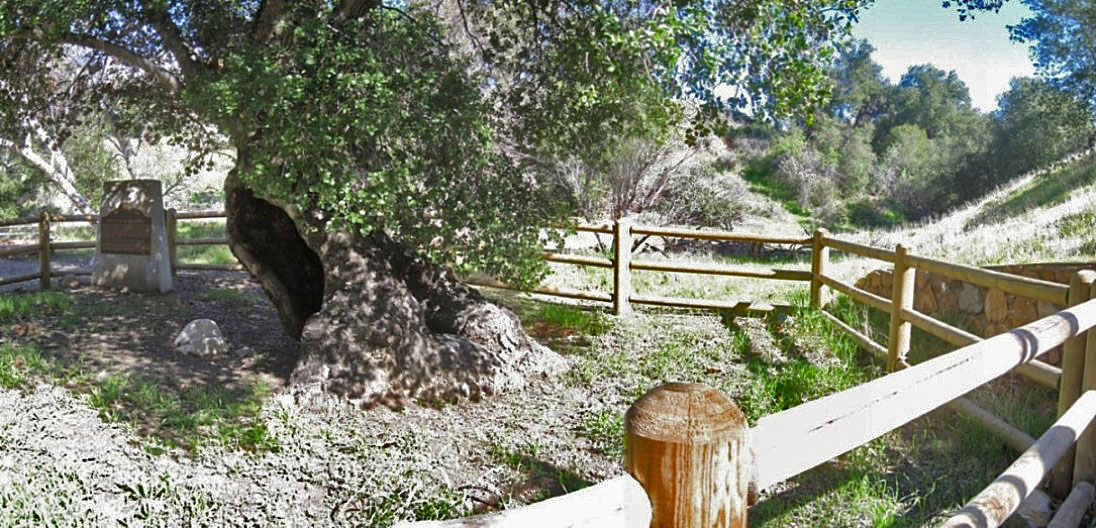
I am going to use the previous Perkins photo to help pinpoint the gold discovery site. I will use the trunk base shape to get the direction line, which is towards the northeast. Making it difficult is that the large horizontal branch fell off in February of 1986 leaving a big hole on the left side of the trunk. It is hard to see the landscape in the background in this photo, but I can see it visually. (2/17/2019)
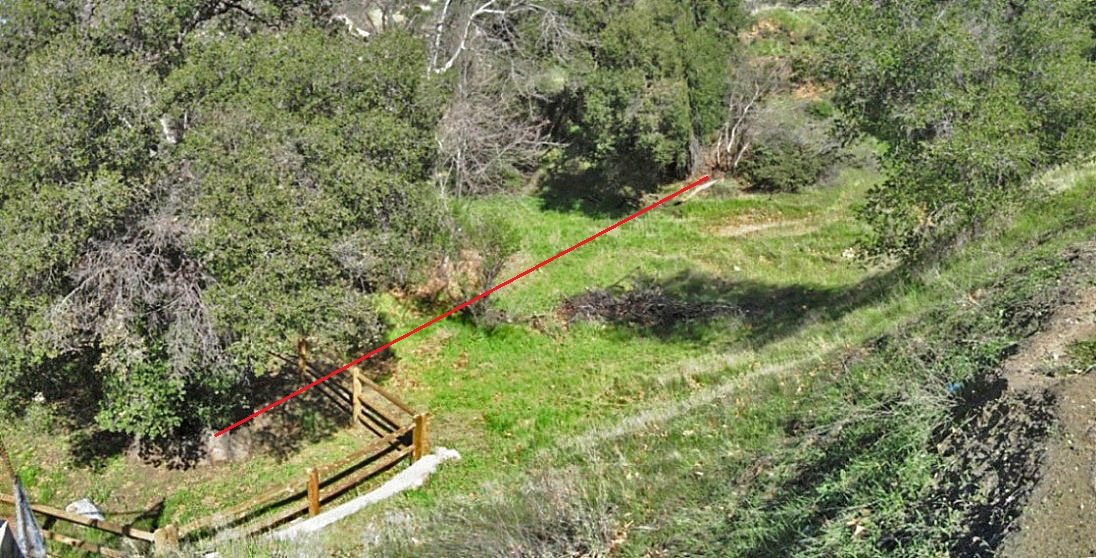
This photo shows the line of sight from the oak to the discovery site. I'm standing on the shoulder of Placerita Canyon Road facing about north. (2/17/2019)
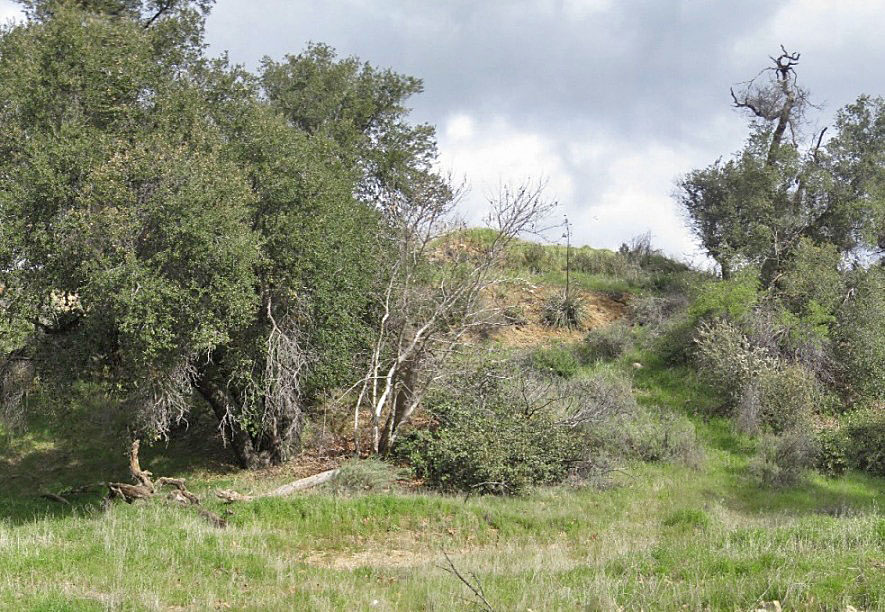
Gold discovery site on 2/20/2019. The light-colored trunks are probably ancestors of the original sycamore trees. Unfortunately, the stones and the stone monument with plaque are all gone. I did not see any sign of them in the area. Therefore, I believe that everything was intentionally removed.
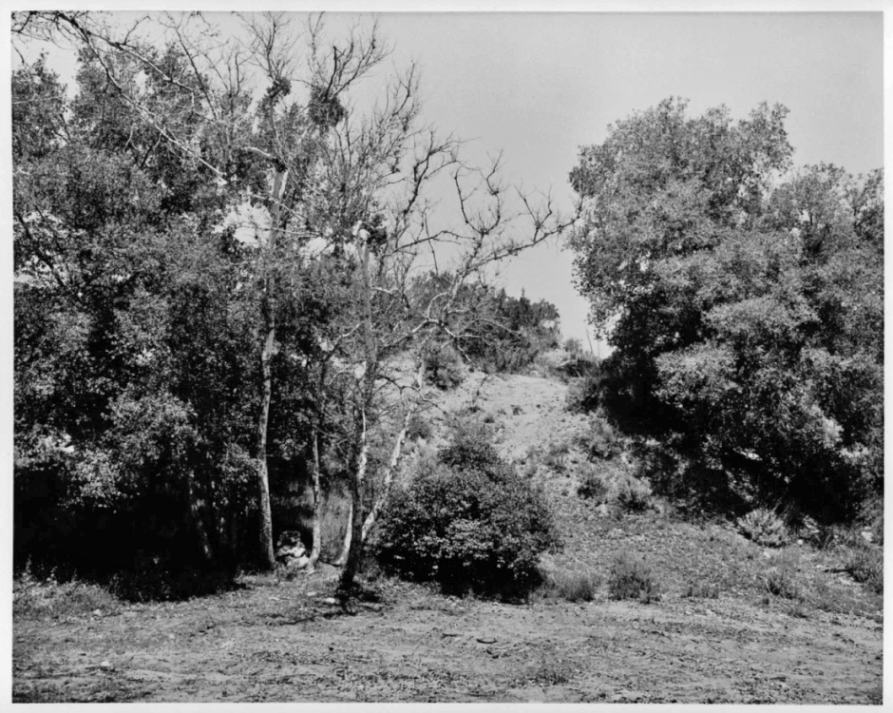
Gold discovery site in undated photo from the California Historical Society Collection, USC Libraries Special Collections.
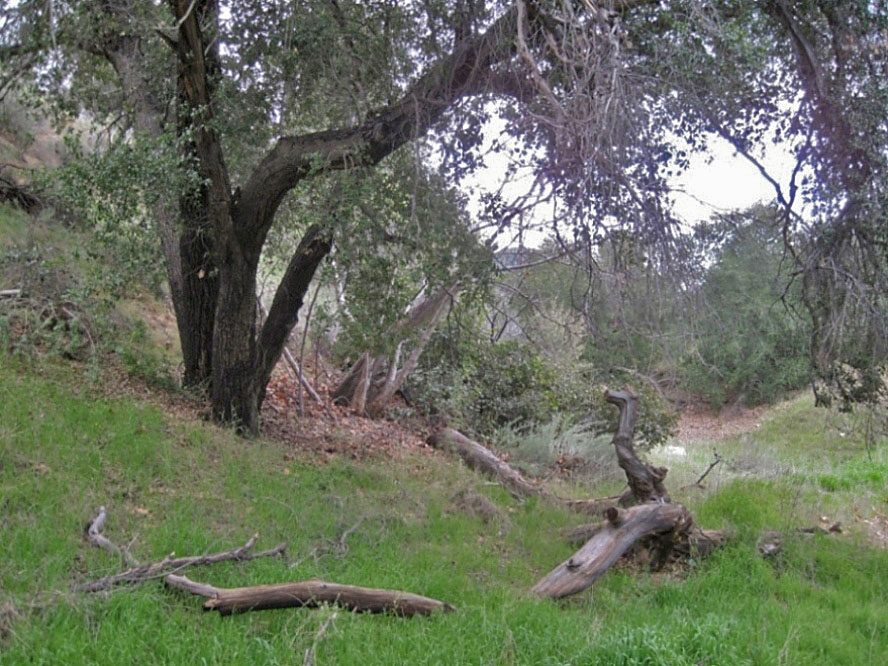
View from the side (2/20/2019).
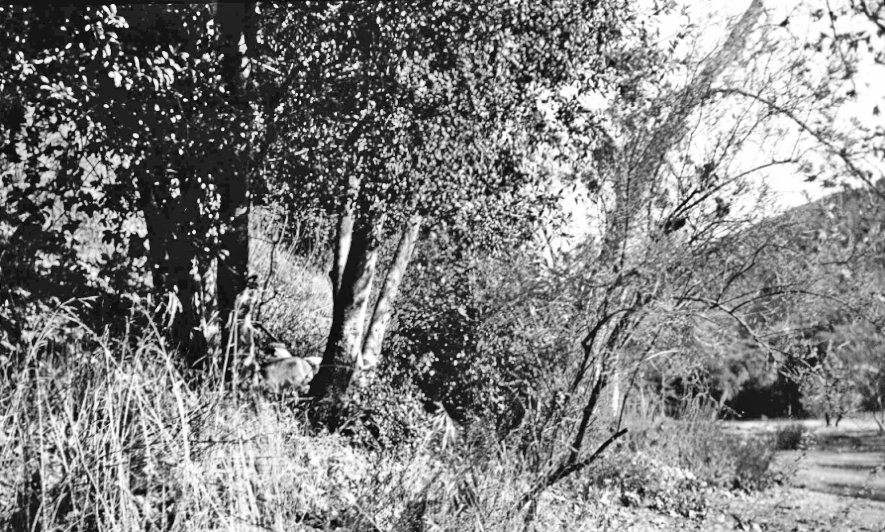
Undated photo from the California Historical Society Collection, USC Libraries Special Collections.
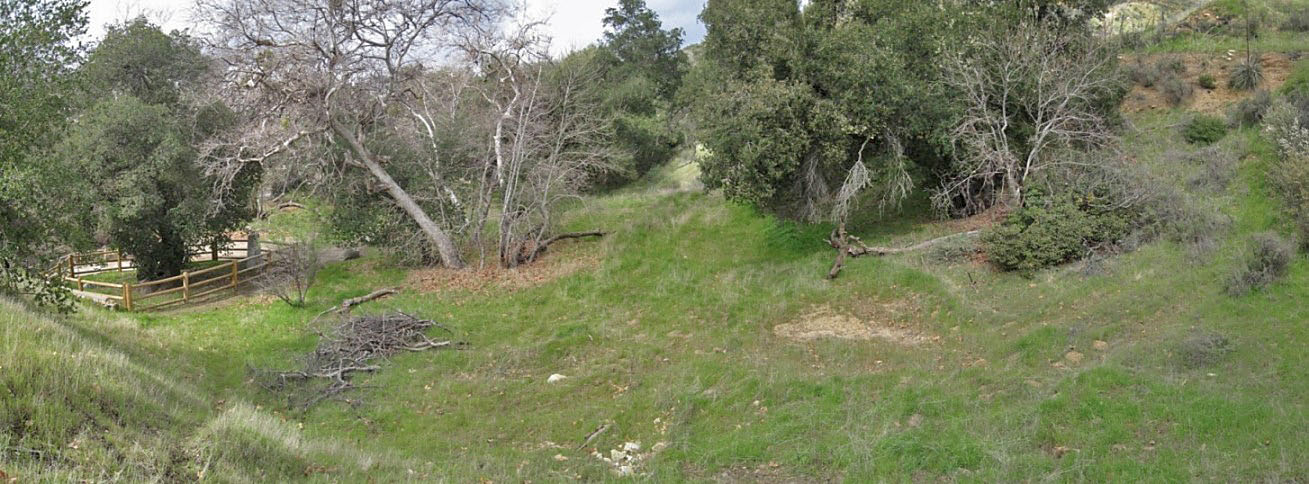
View from just below Placerita Canyon Road. Oak of the Golden Dream on the left and gold discovery site on right. (2/20/2019).
More Historic Photos
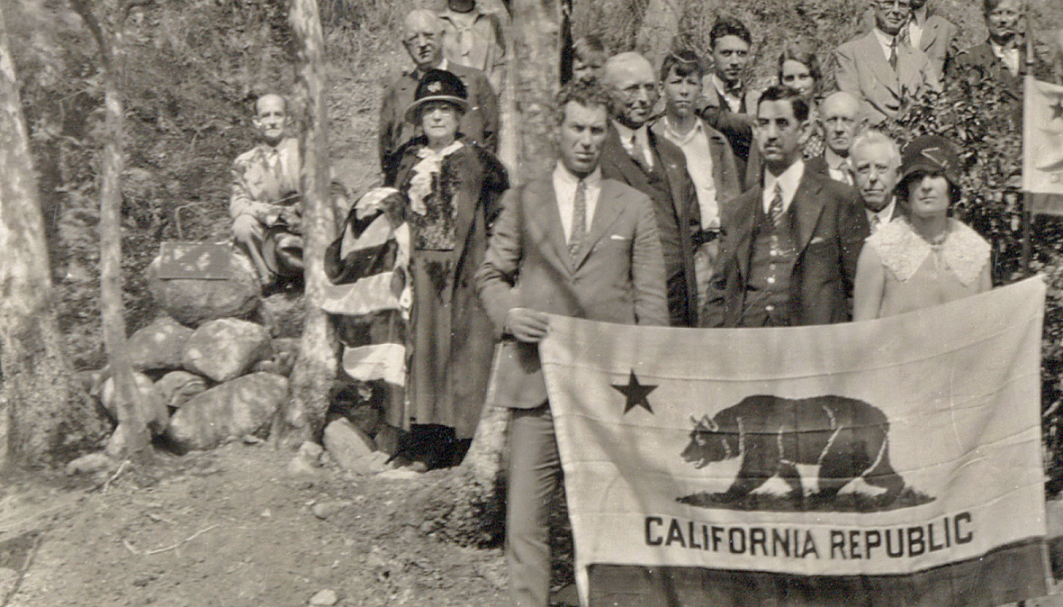
Another blow-up of the 1930 panorama photo. On the far left is the pile of stones where Lopez supposedly first discovered the gold. The plaque is on the top stone. Just to the right of that is Francisca Lopez de Belderrain (the older lady with the black hat). A little more to the right are Frank and Hortense Walker holding the large California Republic flag. The man between them with the black hair and mustache is Adolfo Rivera, the Master of Ceremonies and Chairman of the Historical Landmarks Committee of Ramona Parlor 109, one of the organizers of the ceremony.
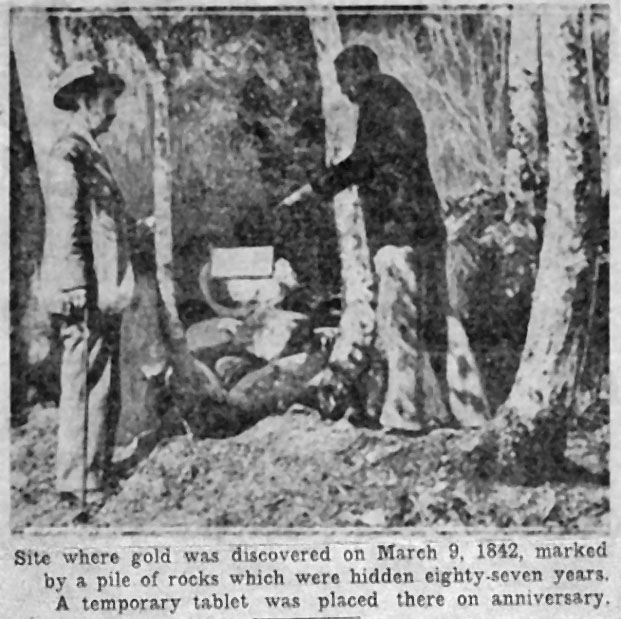
From the Los Angeles Examiner of March 16, 1930.
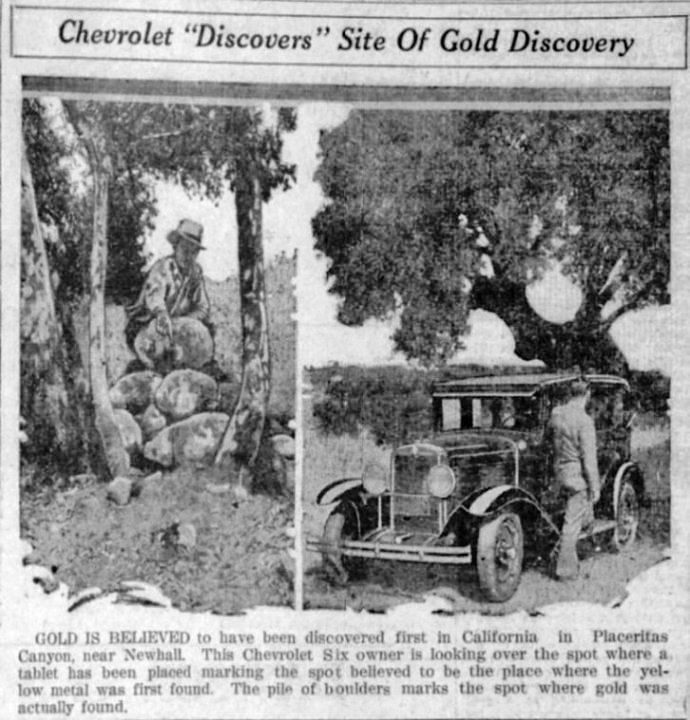
From the Press Democrat of Santa Rosa, California, June 29, 1930.

Title: "Site of First Gold Discovery in Calif. Don Carlos Prudhomme, Mrs. McCloney (Lopez), Mrs. Jesus Bilderrain." ca. 1930. From The Westerner's Brand Book, Los Angeles Corral, 1948.

Pre-1937 photo showing the plaque still laying on a rock behind the stone pile found by Frank Walker. Historical Society of Southern California Collection - Charles Puck Collection of Negatives and Photographs. The Huntington Library, San Marino, California.
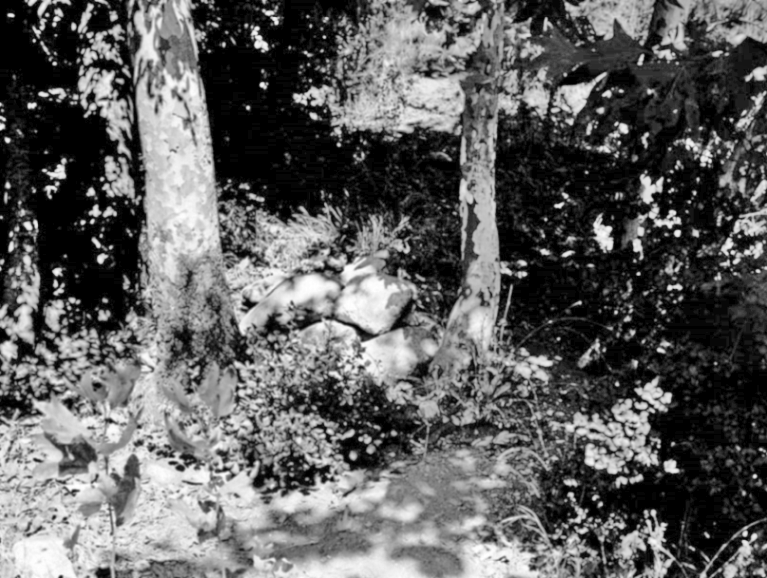
Not only has the smaller trunk in the front has been removed but the large rock with the plaque is gone. In fact, the plaque had been stolen in 1936. Photo date October 28, 1937. From the Works Progress Administration Collection, Los Angeles Public Library.
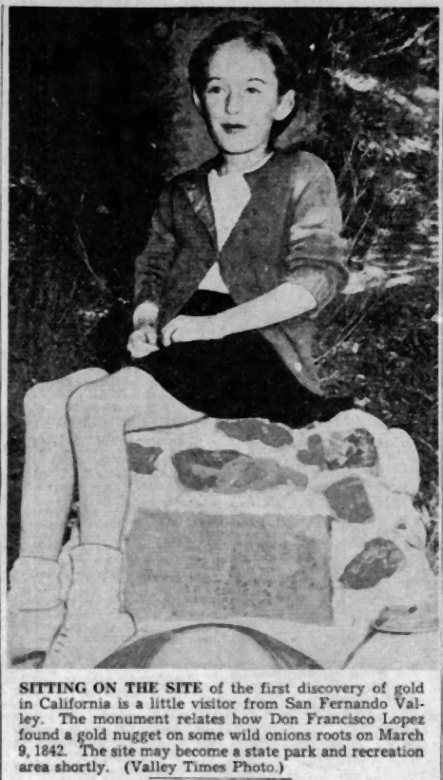
From the Valley Times of January 20, 1947.
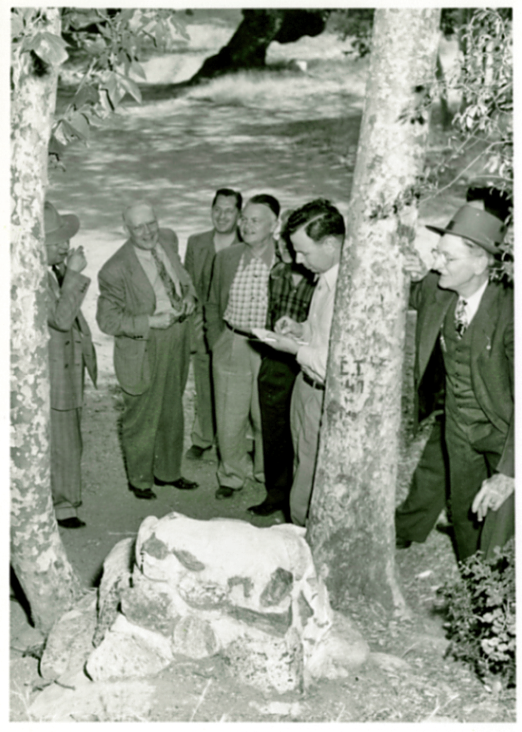
Here is the gold discovery monument in the foreground and the Oak of the Golden Dream in the background. This image further confirms the location of the site relative to the oak. Title: "Group at site of the Oak of the Golden Dream, Placeritas. 1948 Jun 25". From the W.W. Robinson papers (Collection 2072), UCLA Library Special Collections, Charles E. Young Research Library, UCLA. Photo published in the Branding Iron of July 1948. The Branding Iron is the quarterly historical publication of the Los Angeles Corral of The Westerners organization.
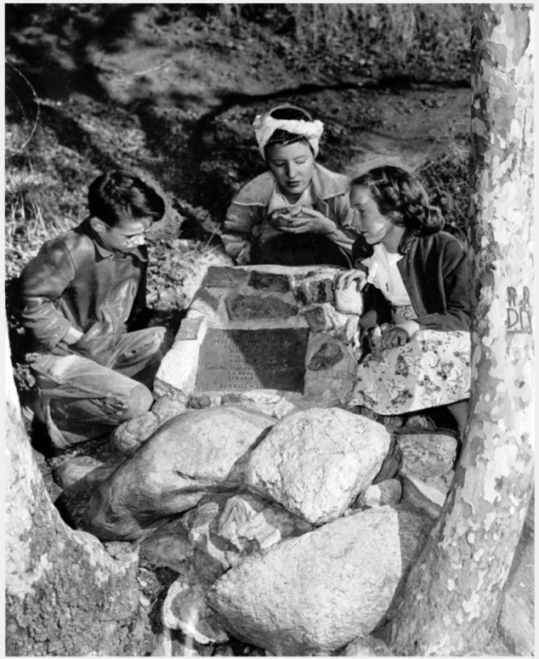
Photograph caption dated March 4, 1949 reads, "This metal marker today rests upon the spot where Lopez found the Placerita nugget clinging to a wild onion root. David Fraser explains the marker to Alice and Helen Flint." From the Valley Times Collection, Los Angeles Public Library.
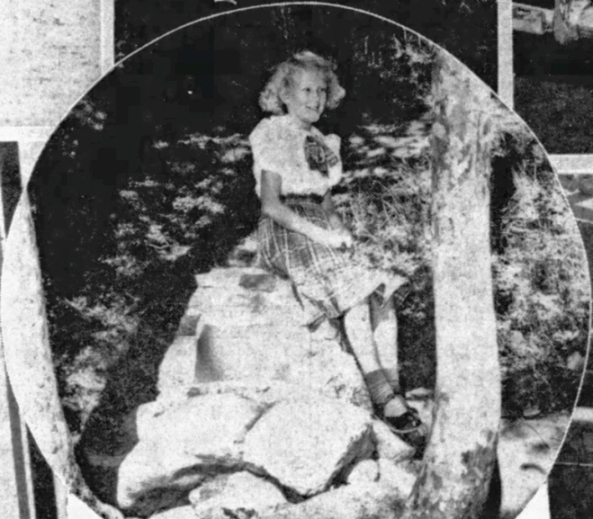
From the Evening-Vanguard (Venice, Ca.) of July 25, 1950.
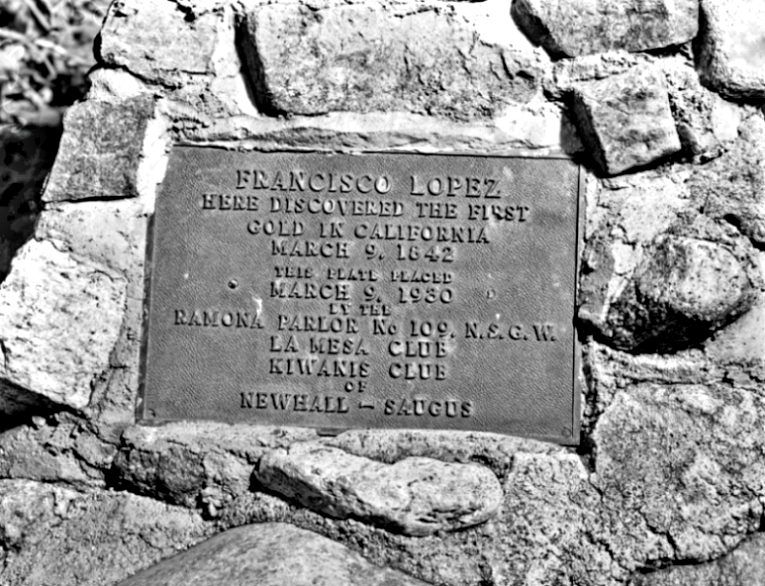
Close-up of marker dated January 10, 1952. From the Los Angeles Examiner Photographs Collection, 1920-1961, USC Libraries Special Collections, University of Southern California.
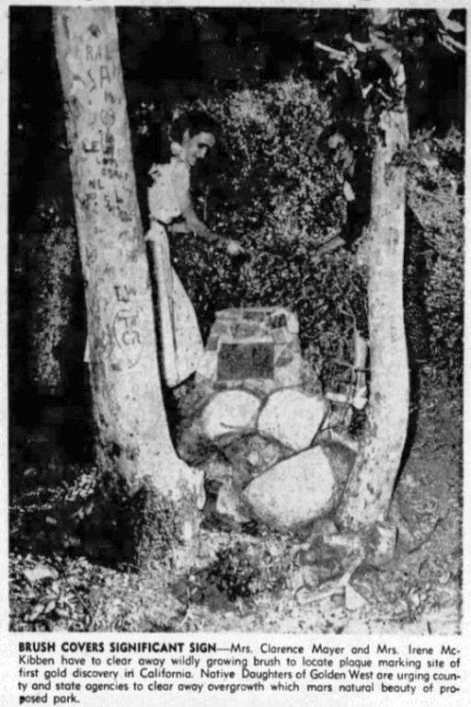
From the Valley Times of October 7, 1952.

Still from a video (Rio Santa Clara, Myna Lou Productions, 1956) on the SCV History website showing the monument. The video section with Placerita Canyon can be seen here. (Used by permission.) The full video can be seen on the SCV History website.
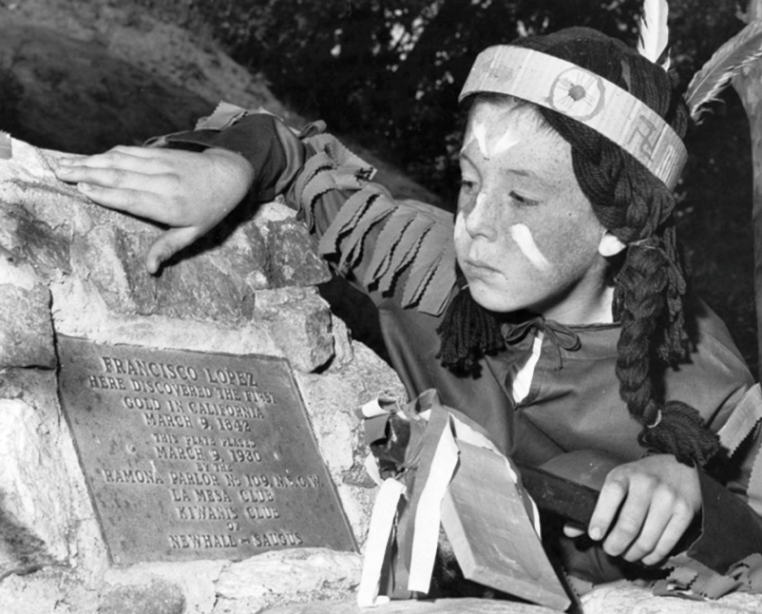
Plaque can be easily read here. Photograph caption dated May 22, 1957 reads, "Injun Mike learns about gold - Brandishing his tomahawk and decked out with feathers on his head, Cub Scout Mike Kill, 11, of Newhall takes time out from world of make believe to read historical landmark at Placerita Canyon State and County park. There will be more palefaces than Indians 2 p.m. Sunday when historical pageant observing first finding of gold in California takes place. Ceremonies will be held three miles east of Newhall on Highway 6." From the Valley Times Collection, Los Angeles Public Library.
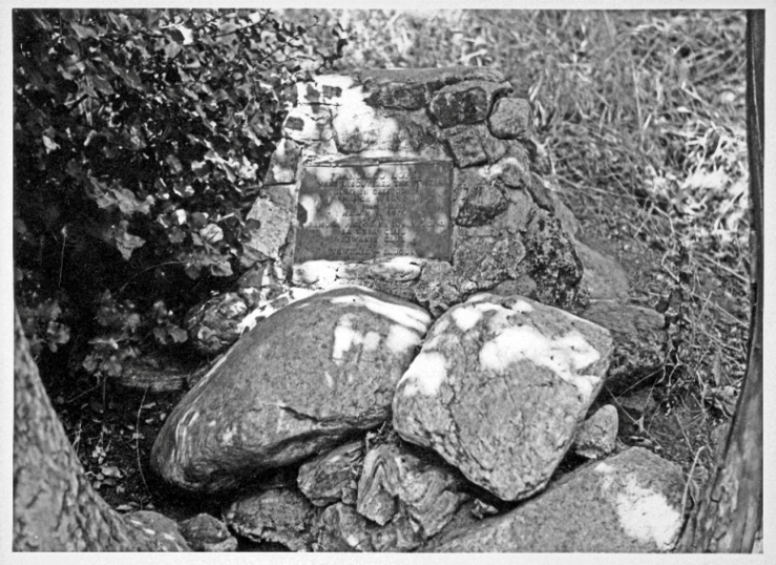
Late 1950's. Placerita Canyon historical marker on the site of the gold discovery here on March 9, 1842, Ralph P. Bieber Photographs of the Overland Trail, The Huntington Library, San Marino, California.
I have not been able to find any information on when the gold discovery stones and monument with plaque were removed, by whom, or why, but I'm sure they were intentionally removed. There are no pieces of rock with traces of cement on them in the area. There are no big boulders similar to the ones in the original stone pile close by (unless they are covered by leaves or buried).
The Russ Leadabrand January 12, 1959 article in the Pasadena Independent. There was also a photo dated 1959. I think that the M, M & P magazine that I quoted above from 1965 was not current but based on earlier information. However, an article in the Los Angeles Times on August 8, 1971, says: "Pass under the culvert and on your right you'll see the oak [of the golden dream]. Behind it, almost hidden by fallen branches, you'll find a marker erected in 1930, crediting Francisco Lopez with discovering the first gold in California." So when the plaque and monument were removed is still a question. If the 1971 article is based on current information, it could have been as late as the early 1970's.
Since there was already a plaque at the oak tree, maybe they (the county?) just decided that one plaque was enough. Who knows? At least the site still exists, is close to the Golden Oak, and on nature center land. It would be easy to put a pile of stones there, just like there used to be.





































